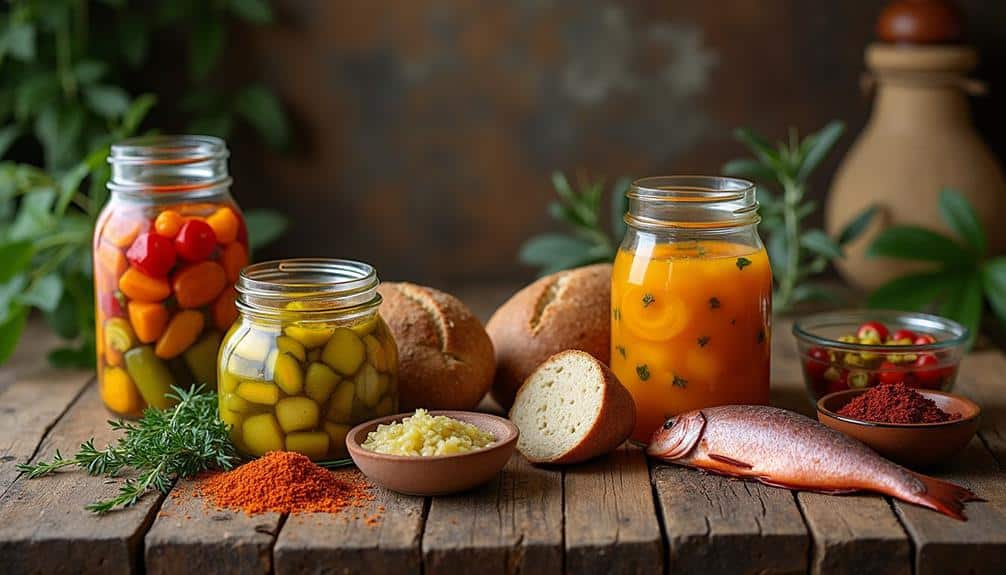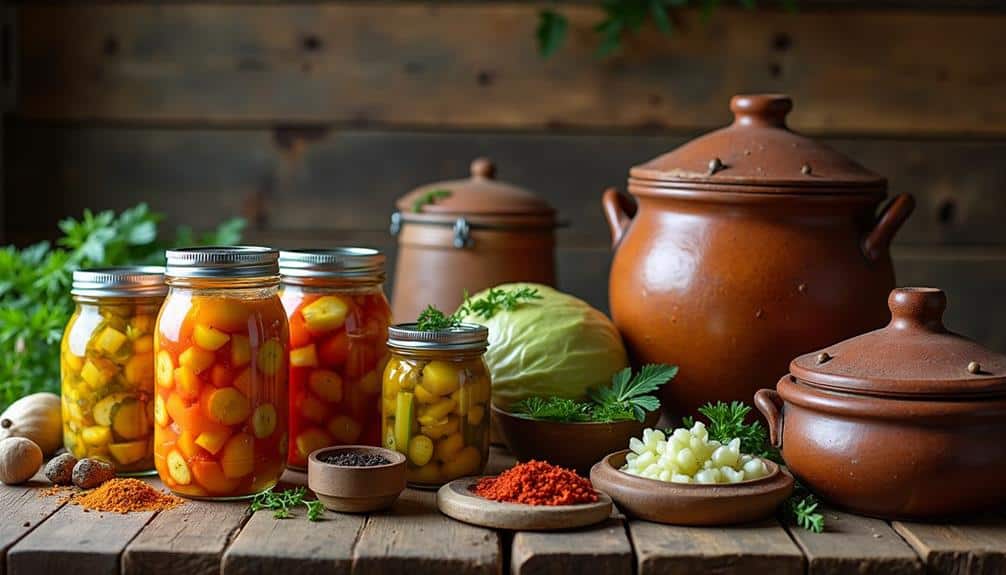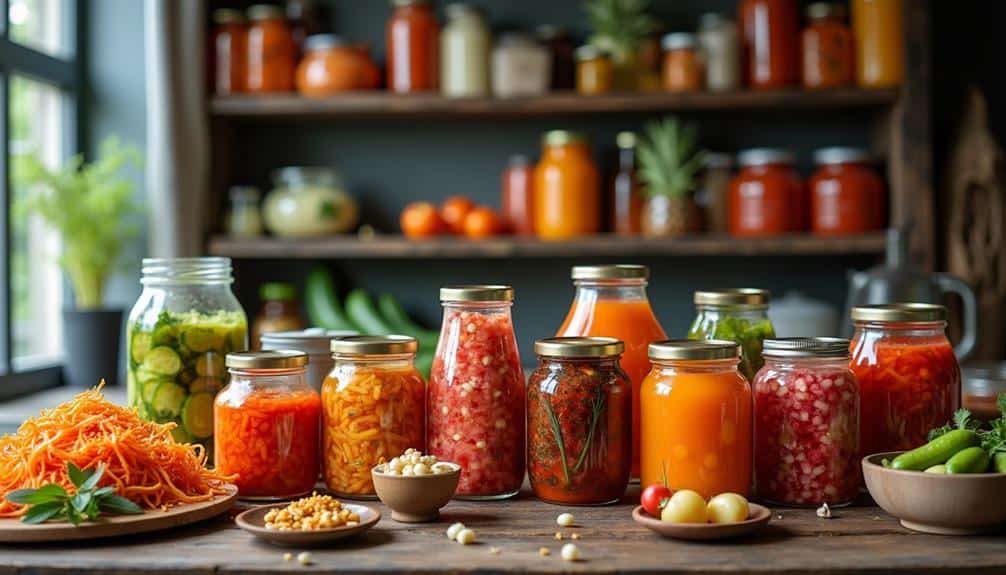Exploring Russia’s fermented food heritage offers a fascinating glimpse into a world where tradition meets innovation. The country’s diverse array of fermented foods, from the effervescent kvass to the creamy kefir, showcases not only culinary creativity but also a profound understanding of natural preservation techniques. These foods, deeply embedded in Russian culture, hold significant health benefits and are celebrated for their roles in social rituals and communal gatherings. As we uncover the layers of history and science behind these age-old practices, the journey promises to reveal surprising intersections with contemporary dietary trends and wellness pursuits.
Traditional Fermented Foods

Traditional fermented foods have long held an essential place in Russian cuisine, showcasing both the ingenuity and resourcefulness of its people. Among the myriad of fermented delights, kvass varieties stand out as quintessential beverages. Made from fermented rye bread, kvass is a mildly alcoholic drink that comes in numerous variations, each with its unique blend of flavors, from sweet to tart.
Sourdough traditions in Russia have also endured through the centuries. The process of fermenting dough to create robust, flavorful bread is a time-honored practice. This method not only enhances the taste but also prolongs the shelf life of the bread, making it a staple in Russian households.
Pickling practices are another cornerstone of Russian culinary heritage. Vegetables such as cucumbers, cabbage, and tomatoes are commonly pickled using a brine solution. This method of preservation guarantees a supply of nutritious vegetables throughout the harsh winters.
Fermented dairy products, including kefir and ryazhenka, are integral to the Russian diet. These dairy items are created by fermenting milk with specific cultures, resulting in beverages that are both rich in probiotics and deeply ingrained in the cultural fabric of Russia.
Health Benefits
Exploring the health benefits of Russian fermented foods reveals a treasure trove of nutritional and medicinal advantages. Central to these benefits are their probiotic properties, which play a vital role in promoting gut health. Probiotics, the beneficial bacteria found in fermented foods such as sauerkraut, kefir, and kvass, contribute to a balanced microbiome. This balance is essential for ideal digestion, nutrient absorption, and immune function.
Russian fermented foods are particularly rich in lactic acid bacteria, known for their ability to enhance gut health by inhibiting pathogenic bacteria and reducing inflammation. Regular consumption of these foods can aid in alleviating gastrointestinal issues such as irritable bowel syndrome (IBS) and bloating.
Furthermore, the fermentation process amplifies the bioavailability of vitamins and minerals, ensuring that the body receives and utilizes essential nutrients more efficiently.
In addition to gut health, these probiotic properties support mental well-being. Emerging research underscores the gut-brain axis, suggesting that a healthy gut can positively influence mood and cognitive functions.
Consequently, incorporating Russian fermented foods into one’s diet not only nurtures physical health but also fosters mental resilience, making them a valuable addition to modern nutrition.
Fermentation Techniques

Mastering the art of fermentation techniques is vital to achieving the unique flavors and health benefits inherent in Russian fermented foods. Central to these techniques is wild fermentation, which relies on naturally occurring microorganisms to initiate and sustain the fermentation process. This method is traditionally preferred in Russia for its ability to produce complex flavors and enhance nutritional profiles without the need for commercial starter cultures.
The choice of fermentation vessels is another significant factor. Historically, Russian fermenters have used wooden barrels, ceramic pots, and glass jars, each imparting distinct characteristics to the final product. Wooden barrels, for example, can introduce subtle woody notes and allow for micro-oxygenation, which can influence the texture and flavor.
Ceramic pots, on the other hand, provide excellent insulation, maintaining a consistent temperature that is vital for successful fermentation.
Temperature control and consistent monitoring are essential. The ideal temperature range for most Russian fermented foods is between 15°C and 22°C. Maintaining this range guarantees ideal microbial activity and prevents spoilage.
Additionally, the use of weights to keep ingredients submerged in brine is a traditional technique that helps create an anaerobic environment, necessary for wild fermentation.
Understanding and mastering these fermentation techniques can elevate the craft, resulting in authentic, flavorful, and health-promoting Russian fermented foods.
Cultural Significance
In Russian culture, fermented foods hold a profound and enduring significance, deeply intertwined with the nation’s history, traditions, and daily life. From the ubiquitous sauerkraut to the time-honored kvass, these culinary staples are much more than mere sustenance; they are emblematic of a shared cultural identity.
Fermented foods frequently feature in festive traditions, serving as integral components of celebratory meals, such as those during Maslenitsa and New Year’s Eve. These events are characterized by an abundance of fermented dishes that symbolize prosperity and health, reinforcing communal bonds.
Moreover, the role of fermented foods extends beyond individual households to communal gatherings. Historically, the preparation of these foods often involved the collective efforts of families and communities, particularly in rural areas. This communal aspect fostered a sense of unity and cooperation, as neighbors would come together to share techniques and labor, ensuring that each household had an ample supply of these nutritious staples for the harsh winter months.
This tradition continues in many regions, where local festivals celebrate the rich tapestry of fermented food heritage.
Thus, fermented foods in Russia serve as a culinary bridge between generations, preserving historical practices and reinforcing the social fabric of communities.
Modern Adaptations

The landscape of Russian fermented foods has undergone significant transformations in recent years, driven by a blend of innovation and globalization. This evolution is marked by the introduction of vegan alternatives and fusion recipes that cater to contemporary dietary preferences and international palates.
Traditional dishes such as sauerkraut and kvass now feature variations using plant-based ingredients, aligning with the growing vegan movement. For instance, beet kvass, traditionally made with rye bread, is now crafted with vegan-friendly sourdough starters, allowing a broader audience to enjoy this quintessential Russian beverage.
Furthermore, fusion recipes are reshaping the way Russian fermented foods are perceived and consumed globally. Chefs and home cooks alike are experimenting by incorporating fermented elements into non-traditional dishes.
Kimchi-infused borscht and kombucha-based marinades illustrate how Russian cuisine is blending with other culinary traditions, creating innovative flavors and textures. These modern adaptations not only preserve the essence of Russian fermentation practices but also extend their reach to new gastronomic territories.





